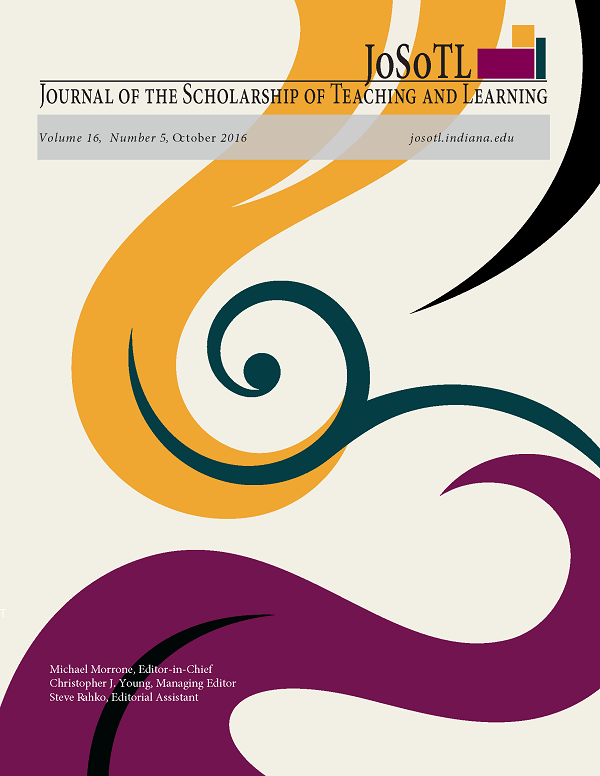Closing the Gap: First Year Success in College Mathematics at an HBCU
Main Article Content
Abstract
Downloads
Article Details
- Authors retain copyright and grant the Journal of the Scholarship of Teaching and Learning (JoSoTL) right of first publication with the work simultaneously licensed under a Creative Commons Attribution License, (CC-BY) 4.0 International, allowing others to share the work with proper acknowledgement and citation of the work's authorship and initial publication in the Journal of the Scholarship of Teaching and Learning.
- Authors are able to enter separate, additional contractual agreements for the non-exclusive distribution of the journal's published version of the work (e.g., post it to an institutional repository or publish it in a book), with an acknowledgement of its initial publication in the Journal of the Scholarship of Teaching and Learning.
- In pursuit of manuscripts of the highest quality, multiple opportunities for mentoring, and greater reach and citation of JoSoTL publications, JoSoTL encourages authors to share their drafts to seek feedback from relevant communities unless the manuscript is already under review or in the publication queue after being accepted. In other words, to be eligible for publication in JoSoTL, manuscripts should not be shared publicly (e.g., online), while under review (after being initially submitted, or after being revised and resubmitted for reconsideration), or upon notice of acceptance and before publication. Once published, authors are strongly encouraged to share the published version widely, with an acknowledgement of its initial publication in the Journal of the Scholarship of Teaching and Learning.
References
ACT, Research. (2013). The reality of college readiness 2013. Retrieved from Iowa City, IA: http://www.act.org/readinessreality/13/index.html
Bahr, Peter Riley. (2008). Does Mathematics Remediation Work?: A Comparative Analysis of Academic Attainment among Community College Students. Research in Higher Education, 49(5), 420-450. doi:10.1007/s11162-008-9089-4
Bahr, Peter Riley. (2010). Preparing the Underprepared: An Analysis of Racial Disparities in Postsecondary Mathematics Remediation. Journal of Higher Education, 81(2), 209 - 237.
Bailey, T., Jeong, D.W., & Cho, S. I. (2010). Referral, enrollment and completion in developmental and educational sequences in community colleges. Economics of Education Review, 29, 255-270. doi:doi:10.1016/j.econedurev.2009.09.002
Bettinger, Eric P., & Long, Bridget Terry. (2009). Addressing the Needs of Underprepared Students in Higher Education: Does College Remediation Work? Journal of Human Resources, 44(3), 736-771.
Boatman, Angela, & Long, Bridget Terry. (2010). Does remediation work for all students? How the effects of post-secondary remedial and developmental courses vary by level of academic preparation. Retrieved from New York, NY:
Calcagno, Juan, C., & Long, Bridget Terry. (2008). The impact of postsecondary remediation using a regression discontinuity approach:Addressing endogenous sorting and noncompliance. Retrieved from Cambridge, MA: http://www.nber.org/papers/w14194
Doyle, William, R. (2012). Playing the Numbers: Remediation: No Easy Answers. Change: The magazine of higher learning, 44(6), 60-63. doi:10.1080/00091383.2012.728956
Kaupp, Ray. (2012). Online penalty: The impact of online instruction on the Latino-White achievement gap. Applied Research in Community Colleges, 12(2), 1-9.
Kreysa, Peter G. (2006). The Impact of Remediation on Persistence of Under-Prepared College Students. Journal of College Student Retention: Research, Theory & Practice, 8(2), 251-270. doi:10.2190/c90c-phwy-g6b2-1n5e
Martorell, Paco, & McFarlin, Isaac. (2010). Help or Hindrance? The Effects of College Remediation on Academic and Labor Market Outcomes. Review of Economics and Statistics, 93(2), 436-454. doi:10.1162/REST_a_00098
Melguizo, Tatiana, Bos, Johannes, & Prather, George. (2013). Are community colleges making good placement decisions in their math trajectories? Retrieved from Los Angeles, CA: OECD. (2014). Education at a Glance 2014: OECD Indicators Retrieved from http://www.oecd.org/education/eag.htm
Perna, Laura, W. (2005). The key to college access: Rigorous academic preparation. In William Tierney, G., Zoe Corwin, B., & Julia Colyar, E. (Eds.), Preparing for College: Nine Elements of Effective Outreach (pp. 113 - 134). New York: SUNY Press.
Rose, Heather, & Betts, Julian, R. (2001). Math matters: The links between high school curriculum, college graduation, and earnings. Retrieved from San Francisco:
Ross, Terris, & Kena, Grace. (2012). Higher Education: Gaps in Access and Persistence Study. Retrieved from Washington, DC: https://nces.ed.gov/pubs2012/2012046.pdf
Scott-Clayton, Judith, & Rodrigues, Olga. (2012). Development, discouragement of diversion? New evidence on the effectiveness of college remediation. Retrieved from Cambridge, MA: www://http://www.nber.org/papers/w18328
Xu, Di, & Jaggars, Shanna, S. (2014). Performance Gaps Between Online and Face-to-Face Courses: Differences Across Types of Students and Academic Subject Areas. Journal of Higher Education, 85(5), 633-659. doi:DOI: 10.1353/jhe.2014.0028
